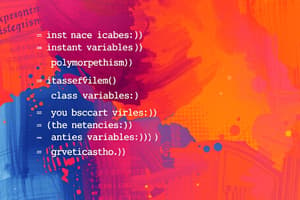Podcast
Questions and Answers
What is the output of the following code: a = [1, 2, 3, 4, 5]; b = a[:]; print(b)
What is the output of the following code: a = [1, 2, 3, 4, 5]; b = a[:]; print(b)
- It will print: [1, 2, 3, 4, 5] (correct)
- It will print: [5, 4, 3, 2, 1]
- It will throw an error
- It will print: []
What is the purpose of the __init__ method in a Python class?
What is the purpose of the __init__ method in a Python class?
- To create a static method
- To define a class variable
- To initialize an object's attributes (correct)
- To override a parent class method
What is the difference between break and continue statements in a Python loop?
What is the difference between break and continue statements in a Python loop?
- `break` is used in `for` loops, `continue` is used in `while` loops
- `break` is used in `while` loops, `continue` is used in `for` loops
- `break` skips to the next iteration, `continue` exits the loop
- `break` exits the loop, `continue` skips to the next iteration (correct)
What is the purpose of the lambda function in Python?
What is the purpose of the lambda function in Python?
What is the difference between is and == operators in Python?
What is the difference between is and == operators in Python?
What is the primary difference between the copy() and deepcopy() functions in Python?
What is the primary difference between the copy() and deepcopy() functions in Python?
What is the purpose of the super() function in a Python class?
What is the purpose of the super() function in a Python class?
What is the difference between the list and tuple data types in Python?
What is the difference between the list and tuple data types in Python?
What is the purpose of the try-except block in Python?
What is the purpose of the try-except block in Python?
What is the purpose of the enumerate() function in Python?
What is the purpose of the enumerate() function in Python?
Flashcards are hidden until you start studying
Study Notes
Python Code Output
- The output of the code
a = [1, 2, 3, 4, 5]; b = a[:]; print(b)is[1, 2, 3, 4, 5], which is a copy of the original lista.
Python Class __init__ Method
- The
__init__method in a Python class is a special method that is automatically called when an object of the class is created. - It is used to initialize the attributes of the class.
- It is a constructor method that sets the initial state of the object.
Python Loop Control Statements
- The
breakstatement in a Python loop is used to exit the loop entirely. - The
continuestatement in a Python loop is used to skip the current iteration and move to the next one.
Python Lambda Function
- The
lambdafunction in Python is a small anonymous function that can take any number of arguments, but can only have one expression. - It is used to create small, one-time use functions.
- It is often used in combination with other functions such as
filter(),map(), andreduce().
Python Identity and Equality Operators
- The
isoperator in Python checks if both variables point to the same object in memory. - The
==operator checks if the values of both variables are equal. - The
isoperator is used for identity comparison, while the==operator is used for equality comparison.
Studying That Suits You
Use AI to generate personalized quizzes and flashcards to suit your learning preferences.




